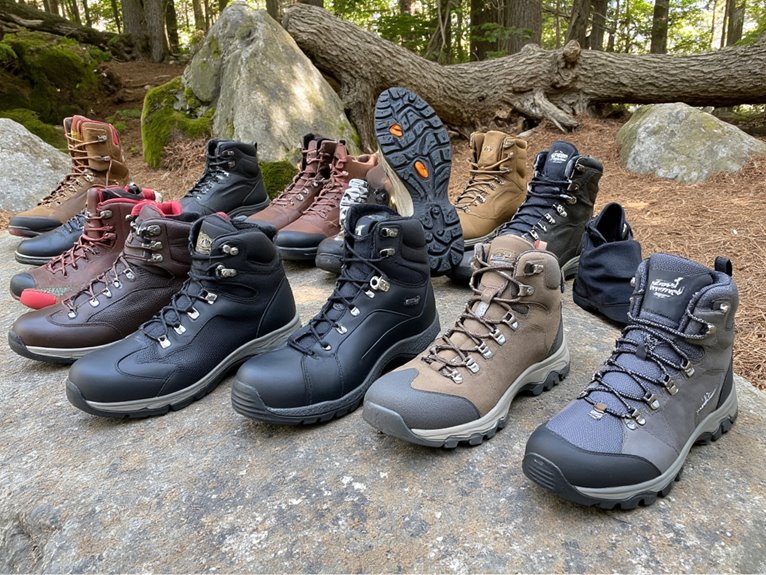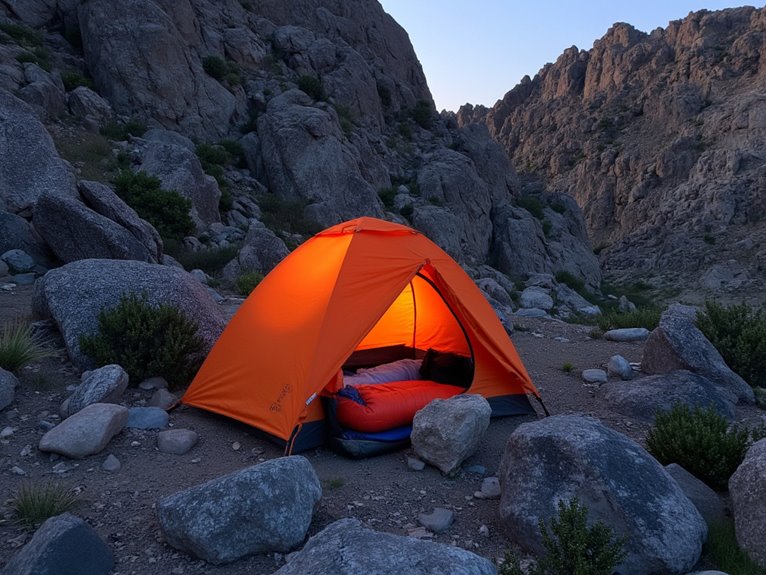Can I Ruck With a Backpack?
You can ruck with a backpack, but it's essential to choose a pack that's specifically designed for rucking. A durable, comfortable backpack with features like weight distribution, hydration system integration, and reinforced seams is vital. Avoid backpacks with unnecessary features that add weight and bulk. A rucking-specific backpack will help you stay focused on your training, not on aching shoulders. And, if you're serious about rucking, you'll want to know more about the features that make a backpack truly ruck-worthy – the details that will make all the difference in your next adventure.
We are supported by our audience. When you purchase through links on our site, we may earn an affiliate commission, at no extra cost for you. Learn more. Last update on 1st January 2026 / Images from Amazon Product Advertising API.
Types of Backpacks Suitable for Rucking
In terms of rucking, not just any backpack will do, and selecting the right type is vital to a comfortable and enjoyable experience.
You'll want a pack that's durable, comfortable, and designed for heavy loads. Look for backpacks made with sturdy materials, such as nylon or polyester, and reinforced seams to prevent tears.
A rucking-specific backpack should also have padded shoulder straps, a hip belt, and multiple compartments to keep your gear organized.
Avoid backpacks with too many bells and whistles, as they can add unnecessary weight and bulk. Instead, opt for a simple, functional design that prioritizes comfort and practicality.
In the realm of rucking, the right backpack is essential, and you'll be ready to tackle even the toughest challenges.
Weight Capacity and Distribution
In the realm of rucking with a backpack, understanding weight capacity and distribution is vital to avoid fatigue, discomfort, and even injury.
Knowing the load capacity limits of your pack and how to strategically distribute weight is key to maintaining balance and stability on the move.
In the context of rucking, mastering these skills is essential to tackling even the toughest challenges with confidence and ease.
Load Capacity Limits
Properly distributing the weight of your gear is essential, as exceeding the recommended load capacity of your backpack can lead to discomfort, fatigue, and even injury.
When packing, consider the 20% rule: your backpack should weigh no more than 20% of your body weight.
For a 150-pound person, that's 30 pounds or less.
Be realistic about what you need and ditch the non-essentials. Remember, you'll be carrying that weight for miles, not just minutes.
Don't be that person who tries to cram 50 pounds into a 30-pound backpack, only to end up with a bruised ego and a sore back.
Know your limits, and your backpack's limits, to guarantee a safe and enjoyable rucking experience.
Weight Distribution Strategies
To optimize your rucking experience, it's essential to master the art of weight distribution, as a well-balanced backpack can make all the difference between a comfortable haul and a grueling ordeal.
Pack heavy items at the bottom: This will help prevent your backpack from tipping forward and throwing you off balance.
Distribute weight evenly: Make sure the weight is evenly distributed across both sides of your backpack to prevent uneven strain on your shoulders and back.
Keep essential items accessible: Pack frequently used items in easy-to-reach pockets to avoid having to remove your backpack during your ruck.
Secure loose items: Use compression straps or pockets to keep loose items from shifting around and throwing off your balance.
Balance and Stability
As you load up your backpack, it's essential to strike a balance between weight capacity and distribution to maintain stability and avoid the dreaded 'ruck-lean,' where your pack threatens to topple you over.
You don't want to be that person who's constantly adjusting their pack mid-stride or, worse, face-planting because of poor weight distribution.
To avoid this, focus on placing heavier items closer to your back and center of gravity.
This will help you maintain balance and stability, even on uneven terrain.
Remember, a well-balanced pack is crucial to a successful ruck.
Durability and Material Considerations
When it comes to rucking with a backpack, the durability of your gear can make all the difference between a successful mission and a miserable one.
The materials used in your backpack's construction can either be your best friend or your worst enemy, depending on their ability to withstand the rigors of heavy loads and harsh environments.
Material Selection Matters
Every rucker's worst nightmare is a backpack that disintegrates mid-hike, leaving them scrambling to gather their scattered gear. When choosing a backpack for rucking, material selection matters. You need a pack that can withstand the rigors of heavy loads, harsh weather, and rough terrain.
Nylon is a durable, water-resistant fabric that's perfect for rucking.
Ripstop is a reinforced fabric that prevents tears from spreading.
PU-coated is a water-resistant treatment that keeps your gear dry.
DWR-finished is a durable, water-repellent finish that sheds water like a pro.
Toughness Under Heavy Loads
A rucker's pack is only as strong as its weakest seam, and a single weak spot can turn a grueling hike into a gear-scattered disaster.
That's why durability is paramount when selecting a rucking backpack. Look for reinforced seams, heavy-duty zippers, and robust materials that can withstand the rigors of heavy loads and harsh environments.
A good rule of thumb is to opt for packs made from abrasion-resistant nylon or polyester, and reinforced with ripstop or Cordura fabric. These materials can withstand the constant rubbing, scraping, and bouncing that occurs during a ruck.
Comfort and Ergonomic Features
Three key comfort and ergonomic features to look for in a rucking backpack are a padded back panel, shoulder straps with ample cushioning, and a hip belt that adequately distributes the weight of the pack.
These features work together to reduce fatigue and discomfort, allowing you to focus on your ruck.
Some additional comfort-boosting features to examine include:
Breathable mesh panels to keep you cool and dry
Adjustable torso lengths to provide a customizable fit
Load stabilizers to keep your gear from shifting around
Ergonomic grip handles for easy lifting and carrying
Size and Compartmentalization Matters
In the domain of choosing the right rucking backpack, size and compartmentalization play a significant role in keeping your gear organized and accessible, allowing you to focus on your training rather than wasting time searching for misplaced items.
A backpack with multiple compartments and pockets helps you categorize and prioritize your gear, ensuring that essentials like water, snacks, and a first-aid kit are easily within reach.
A well-organized pack also reduces the likelihood of forgotten items, saving you from mid-ruck panic attacks.
Look for a backpack with dedicated spaces for your gear, and consider a pack with adjustable compartments to customize your storage needs.
With a thoughtfully designed backpack, you can ruck on, worry-free.
Rucking-Specific Features to Look For
When selecting a rucking backpack, it's essential to prioritize features that address the unique demands of rucking, such as hydration systems, MOLLE compatibility, and reinforced stress points. These features can make a significant difference in your rucking experience.
Hydration system integration: A built-in hydration sleeve or compartment provides easy access to water on-the-go.
MOLLE compatibility: Modular attachment points allow you to customize your backpack with additional gear, such as first aid kits or ammo pouches.
Reinforced stress points: Heavy-duty stitching and reinforced materials at high-wear areas protect your backpack from damage and withstand the rigors of rucking.
Ventilation and drainage: Breathable mesh panels and drainage holes help keep you cool and dry, even during intense rucking sessions, promoting comfort and preventing moisture buildup.
Converting a Hiking Backpack for Rucking
You don't necessarily need to invest in a brand-new rucking backpack, as a hiking backpack can be converted to meet your rucking needs with a few modifications.
First, add a sternum strap to distribute the weight more evenly.
Next, consider adding a hip belt or padded waist strap to take some pressure off your shoulders.
You can also add extra padding or inserts to the back panel for comfort.
Finally, make sure your backpack has multiple compartments to keep your gear organized and within reach.
With these tweaks, your trusty hiking backpack can become a reliable rucking companion.
Just remember, a little creativity and resourcefulness can go a long way in converting your hiking backpack for rucking.
When to Invest in a Rucking Backpack
Upgrade to a dedicated rucking backpack when your modified hiking pack can no longer keep up with the demands of your rucking routine. You know it's time to invest in a specialized pack when you're constantly adjusting straps, dealing with bouncing weights, or struggling to stay comfortable during long rucks.
Signs it's time to level up include:
Your pack is causing discomfort: If you're experiencing back, shoulder, or hip pain due to an ill-fitting pack, it's time to upgrade.
You're modifying your pack excessively: If you've added multiple DIY fixes, it might be time to invest in a pack designed specifically for rucking.
You're rucking frequently: If rucking becomes a regular part of your fitness routine, a dedicated pack will make a huge difference.
You're carrying heavy weights: If you're hauling heavy weights regularly, a rucking backpack will provide the necessary support and comfort.
Investing in a dedicated rucking backpack will improve your overall experience, allowing you to focus on your fitness goals rather than struggling with your gear.




